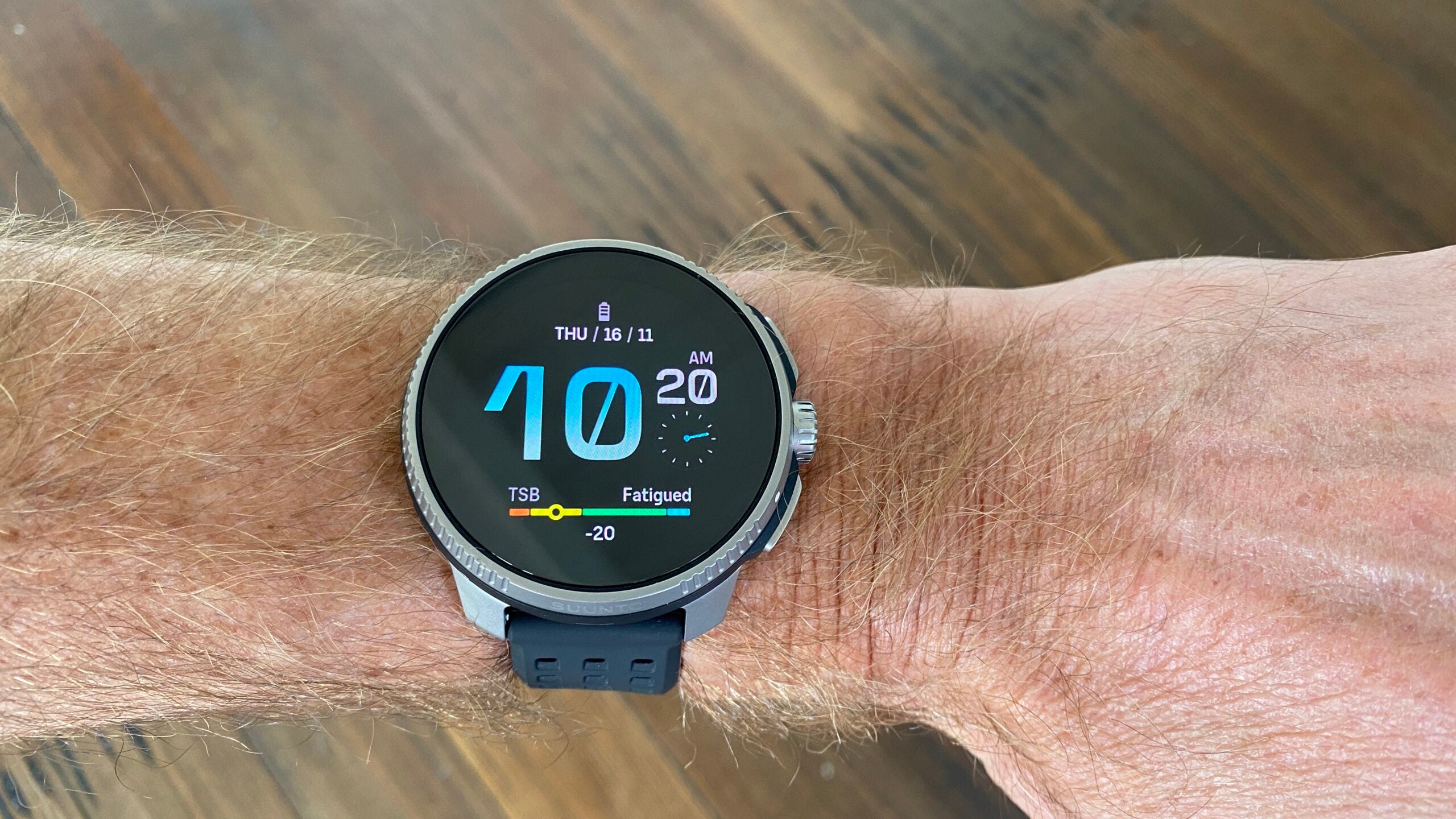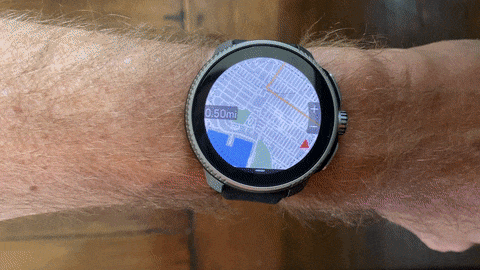Heading out the door? Read this article on the new Outside+ app available now on iOS devices for members! Download the app.
Suunto Race Smartwatch Review
This is the second new model smartwatch that Suunto has released this year, wisely continuing to stray from the confusing “number-followed-by-a-not-useful-word” naming convention they had previously used (Suunto 9 Baro, Suunto 9 Peak, Suunto 9 Peak Pro, etc. for instance). Only months after announcing the very cool Suunto Vertical—which has become a favorite for its big battery life and offline mapping capabilities—Suunto has released its second AMOLED-screened watch, the Suunto Race.
Though the Suunto 7 was their first AMOLED touchscreen watch, it was troublesome because of its very low heart-rate accuracy, battery life, and buggy WearOS system. It was more of a watch for the casual “fitness” person; definitely not a watch for a “2-3 sports/day” triathlete or someone doing serious endurance outdoor activities. So while this isn’t the first Suunto AMOLED watch, it’s the first one that is really capable for serious endurance athletes. Let’s dive in.
RELATED: More Running Tech at Women’s Running
Section dividerSuunto Race Review: The Basics

Suunto really spent some time on both this and the new Vertical—rather than just slightly upgrading a few things here and there, they added a lot of features athletes in these categories actually need and use. And the two watches are different enough to both make sense. First, the biggest difference between the Vertical and the Race is the 1,000-nit maximum AMOLED 36mm touchscreen on the latter. It’s also bigger than the touchscreen on the Vertical, but only slightly, though the Race’s screen’s resolution is much higher so you get substantially more space for more info. The Race has quite a bit lower battery life (26 days of very basic smartwatch, with no HR tracking or workouts; 40 hours of all-on GPS for the Race) and a digital crown that the Vertical doesn’t have.
In terms of standalone features, the Race has the full complement of multisport sport modes like open-water swimming, pool swimming, cycling, running (with on-wrist running with power), triathlon, and catch-all multisport. Suunto gives you access to a library of fantastic offline maps that you can download to the Race’s reasonably big onboard storage (16GB for the steel, 32GB for the titanium version), though both Suuntos don’t support onboard music, both will control smartphone music. The Race also notably has onboard HRV (heart rate variability) and sleep tracking with decent performance/recovery metrics, training/workout creation, and very accurate dual-band GPS.
Section dividerSuunto Race Review: What We Liked
There was a lot to like on this watch, and in very different ways than the Vertical—which was a surprise. First, it’s worth noting up top that the Race is a very, very good value for a fully functional, fully-multisport-loaded, AMOLED smartwatch. $450 is precisely the price of AMOLED competitor, the Garmin Forerunner 265, but a much larger battery (basically double) and (excellent) onboard mapping push the Race way way ahead. In fact, the Race is a closer competitor to the $600 Forerunner 965 in many ways (though not all).

This brings us to the second most impressive thing about the Race, something that surprised us: the excellent navigation/mapping. While not every triathlete will actually use this feature, having bright, crisp, hi-res onboard mapping, with a touchscreen and digital crown mean you’ll be more likely to use them. All of those things, when added to Suunto’s top shelf routing via the smartphone app (we love the heat mapping for finding new, not-dangerous trails when traveling), make it potentially the most useful smartwatch, in terms of navigation, that we’ve ever tested. The bright AMOLED screen gives great detail, the available maps are detailed (and free), and the touchscreen-plus-digital-crown means you can pan and zoom quickly and accurately—something almost no other brand does well.

Finally, we were impressed with the dual-band GPS for accuracy on land and in the open-water, with excellent consistency in the latter (really the only important thing in open-water swimming). The sport modes work as well as any, and there’s nothing missing for multisport athletes in terms of HRV measurement, recovery, fatigue assessment, training readiness, etc.
Section dividerSuunto Race Review: What Could Be (Slightly) Better
This is a tough one, because like the Vertical, we’re dealing with a very very good smartwatch, so we’re just being a little picky in this section. First, we found the raise-to-wake and other display updating/processing functions to be very slow. It’s not a big deal most of the time, but when you compare it to other watches, even cheaper ones, it does stand out. While it never caused any problems (like missed laps or lost splits), there is a learning curve on knowing how long you have to wait to make something happen on the Race. The raise-to-wake in particular is very “sticky” and doesn’t always work or work on time. On that same note, out of the box, the Race is set up very very “battery-optimization-heavy” and for most people will require quite a bit of customization to get it somewhere usable.

On the note of customization, Suunto’s system is still a little behind when it comes to things like watch faces, data display options on the watch faces, and—most importantly—data field customization in sport mode. First, you’re technically only limited to three fully customizable screens in each sport mode, though you can supplement those three with additional pre-loaded “SuuntoPlus” screens. Second, you don’t have the full breadth of data available to place in those data fields, like you do on most watches. Some are “locked” to the SuuntoPlus screens (which can’t be customized)—most notably the “Normalized Graded Pace” metric that converts your effort into minutes/mile taking into account elevation/grade. Strava and Garmin users call this “GAP” or Grade-Adjusted Pace; Coros calls it “Effort Pace.” All of these complaints were the same in our review of the Vertical, so it’s nothing specific to the Race, just Suunto’s OS.
More on the pickier side of things, we did find the battery life to be slightly over-advertised when the Race was used with lots of workouts and the settings were “unoptimized” for easier use of the screen day-to-day, so we’d take it down more to a 12-to-20-day capacity for true multisport living. This is still very good for the price and still beats the Forerunner 265 handily, apples-to-apples. Finally, the last little note is that some of the offline maps are very large (like >1GB) and can take a very long time to download via the smartwatch’s WiFi connection, so just be sure you leave enough time before you head out.
Section dividerConclusions
Sure, it’s easy to pick apart a watch when you put it against the sum of all other smartwatches at all prices, but when you put the Race against its competitors, it’s certainly top of the class. The funky little hardware issues, the customization stuff, and even the slightly reduced battery life and long download time are all things I probably wouldn’t even notice if I haven’t used dozens of other smartwatches extensively—many of which cost almost three times as much as the Race. If the Race was your first, second, or third smartwatch, you’d probably think you’d gotten a steal and use it until you (somehow) broke it.
So with that in mind, I was super close to giving out a rare five-star rating on the Race simply because Suunto priced this thing super competitively (which is really important to me), they thought the feature list through very carefully, and I’d have a hard time thinking of what else I’d actually need as a multi-sport athlete—even if money were no object. The Race lost that half star only because of the painfully slow raise-to-wake. I can excuse the slow processor and refresh, because of course you spend more money, you get better things, but I’m really hoping Suunto drills down on the Race’s wake issues because they’re so noticeable compared to its competition. That said, to Suunto: Hats off for the best endurance smartwatch you’ve ever made—and one of the best on the market right now.
Section dividerCompetitive Comparison
Suunto Race vs. Suunto Vertical vs. Garmin Forerunner 265 vs. Coros Apex 2 Pro
*For more smartwatch reviews, check out The Best Smartwatches of 2023, Reviewed
| Suunto Race | Suunto Vertical | Garmin Forerunner 265 | Coros Apex 2 Pro | |
| Price | $450 | $630 | $540 | $450 |
| Weight | 83 g | 86 g | 47 g | 66 g |
| Touch Screen | 36mm AMOLED, 466x466 | 3.5mm Matrix, 280x280 | 32.5 AMOLED, 416x416 | 33m LCD, 260x260 |
| Battery Life | 26 days smartwatch, 40+ hours GPS | 30-60 days smartwatch, 60 hours+ GPS | 13 days smartwatch, 14-20 hours GPS | 30 days smartwatch, 26-45 hours gps |
| Real-World Triathlete Battery Life | 12-20 days | 22-30 days | 5-8 days | 20-25 days |
| Open-Water Swimming | Yes | Yes | Yes | Yes |
| Cycling with Power Connectivity | Yes | Yes | Yes | Yes |
| Running With Power | Built-in | Built-in | Built-in | Built-in |
| Triathlon Mode | Yes | Yes | Yes, Auto-transition | Yes |
| Brick Mode | Yes | Yes | Yes, Auto-Transition | Yes |
| Offline Mapping/Navigation | Yes | Yes | No | Yes |
| GPS | Multi-band | Multi-band | Multi-band | Multi-band |
| Onboard Music | No | No | Yes | Yes |
| Third-Party Apps | Yes | Yes | Yes | No |
DMTBeautySpot
via https://dmtbeautyspot.com
POM Administrator, DMT.NEWS, DMT BeautySpot,


0 comments